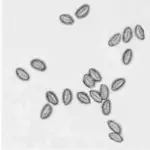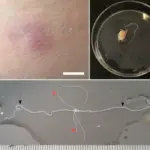Lymphatic filariasis infection is a neglected tropical disease NTD, is a parasitic disease caused by microscopic, thread-like worms.
What is the Pathology of Lymphatic Filariasis Infection?
The pathology of lymphatic filariasis infection is:
-Etiology: The cause of lymphatic filariasis infection are parasites.
-Genes involved: Not applicable.
-Pathogenesis: The sequence of events that lead to lymphatic filariasis infection includes bite from an infected mosquito introduces third stage infective filarial larvae onto the human skin, they penetrate into the bite wound to reach the lymphatics where they reside and develop into adults.
-Morphology: The morphology associated with lymphatic filariasis infection shows microfilariae, or larval stage of W. bancrofti, are sheathed, and range from approximately 245 to 300 µm.
-Histology: The histology associated with lymphatic filariasis infection shows microfilariae are the diagnostic form, intact adult filariae in lymph nodes are pathognomonic; may see dead filariae with surrounding granulomatous inflammation and calcifications.
How does Lymphatic Filariasis Infection Present?
Patients with lymphatic filariasis infection typically are all genders but males are at greater risk at age ranges from 9 to 16 years. The symptoms, features, and clinical findings associated with lymphatic filariasis infection include pain in the limbs, swollen lymph nodes, and fever.
How is Lymphatic Filariasis Infection Diagnosed?
Lymphatic filariasis infection is diagnosed by blood tests.
How is Lymphatic Filariasis Infection Treated?
Lymphatic filariasis infection is treated by medications Diethylcarbamazine citrate.
What is the Prognosis of Lymphatic Filariasis Infection?
The prognosis of lymphatic filariasis infection is good if infection is recognized and treated early.



